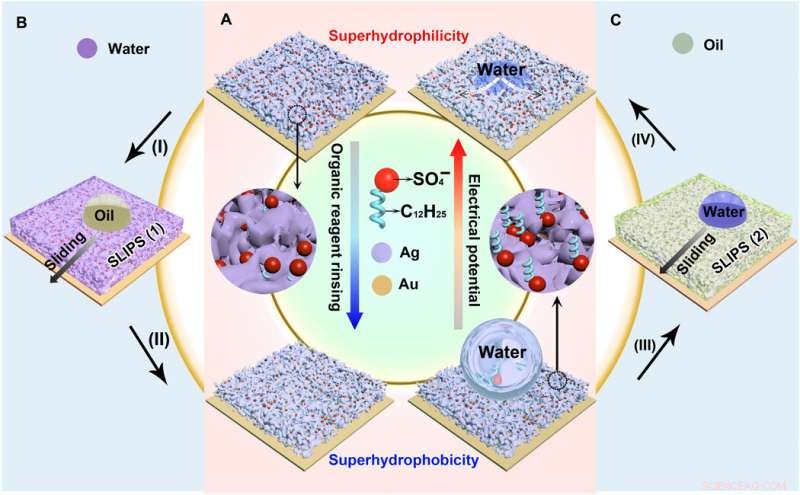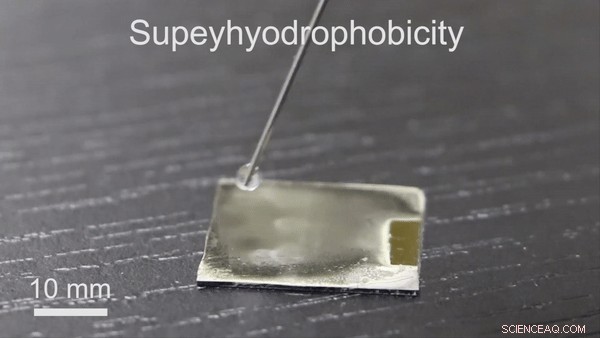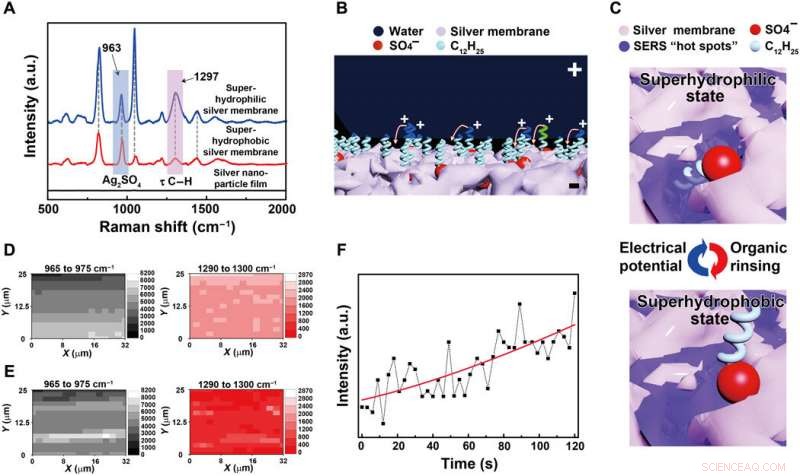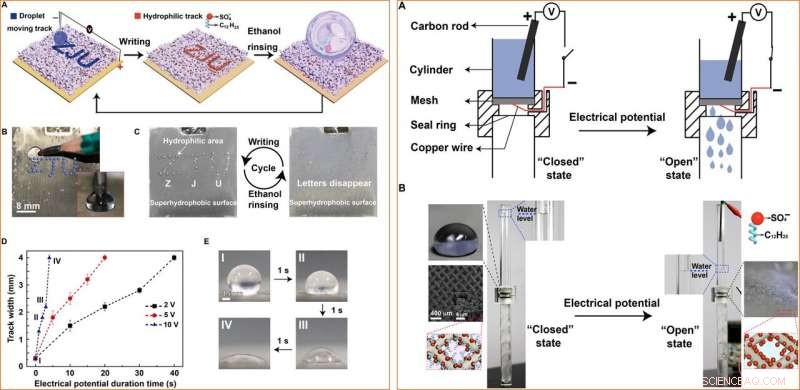
Conmutación reversible de la humectabilidad y la repelencia a líquidos de las membranas porosas de plata electrodepositadas. (A) Transición de humectabilidad reversible de superhidrófilo a superhidrófobo, habilitado por el cambio de orientación de los iones dodecilsulfato. (B) SLIPS 1 se forma infundiendo agua en la membrana porosa superhidrófila (proceso I), que puede repeler el aceite. Después de enjuagar con etanol (proceso II), SLIPS 1 se vuelve superhidrofóbico. (C) El aceite se infunde en la membrana porosa superhidrofóbica (proceso III), formando SLIPS 2. El agua será repelida por SLIPS 2. El aceite lubricante será liberado de SLIPS 2 bajo un potencial eléctrico (proceso IV), dando lugar a una membrana porosa superhidrófila. Crédito:Science Advances, doi:10.1126 / sciadv.aax0380
Las tecnologías de ingeniería de materiales tienen como objetivo controlar la humectabilidad y la repelencia a líquidos de las superficies de los materiales para diversas aplicaciones dentro y fuera del campo de la ciencia de los materiales. En un informe reciente sobre Avances de la ciencia , Yue Liu y un equipo de investigadores de los departamentos de Ciencia e Ingeniería de Materiales, y Química e Ingeniería Molecular en China desarrollaron un concepto general para desarrollar superficies metálicas porosas con excepcionalmente poderosas, Capacidades de cambio de mojabilidad. Para diseñar las nuevas superficies, usaron un extremadamente simple, proceso de deposición electroquímica de un solo paso. El equipo habilitó el interruptor de humectabilidad y manipuló las propiedades repelentes de líquidos cambiando la orientación de los iones de dodecilsulfato que se unieron iónicamente a las membranas metálicas porosas durante la electrodeposición. Las superficies resultantes con humectabilidad ajustable podrían atrapar diversos lubricantes a demanda en los poros para crear superficies porosas con infusión de líquido personalizadas para una variedad de propiedades repelentes de líquidos. El equipo de investigación demostró las aplicaciones de las membranas porosas con infusión líquida para el cifrado, para controlar la transferencia de gotas y para la recolección de agua. Adicionalmente, los materiales que los científicos recubrieron con la membrana porosa plateada sobre una malla de cobre para diseñar una compuerta de líquido antiincrustante para permitir el paso de aceite o agua a pedido.
En ingeniería de materiales, Los investigadores tienen como objetivo desarrollar propiedades interfaciales intercambiables reversiblemente para diversas aplicaciones de sistemas de microfluidos, a la recolección y el transporte de agua, así como separadores, sensores y sistemas de administración de fármacos. Los científicos de materiales han estudiado extensamente tales superficies de humectabilidad conmutable controladas a través de estímulos externos, incluida la luz, valor de pH, tratamiento térmico y electroquímico, contraiones y potenciales eléctricos. En el presente trabajo, Liu y col. informó un extremadamente simple, Enfoque de electrodeposición de un solo paso para diseñar superficies metálicas porosas con robustas capacidades de conmutación de humectabilidad junto con excelentes propiedades repelentes de líquidos que diferían de los mecanismos informados anteriormente para diseñar un nuevo interruptor de humectabilidad.
Humectabilidad reversible de ingeniería en superficies porosas electrodepositadas
Liu y col. moduló la orientación de los iones de dodecilsulfato que se unieron iónicamente a la membrana porosa durante la electrodeposición para establecer la humectabilidad de la superficie sintonizable reversiblemente. Por ejemplo, cuando las cadenas de dodecilo apuntaban hacia afuera, la membrana retuvo la superhidrofobicidad (naturaleza que odia el agua). Luego, los investigadores utilizaron potenciales eléctricos para hacer la transición de la humectabilidad del estado superhidrofóbico (que odia el agua) al estado superhidrófilo (que ama el agua). Confirmaron los cambios de orientación de la superficie iónica utilizando mediciones de dispersión Raman mejorada en la superficie (SERS). Basado en la evolución inducida por la orientación iónica de superficies porosas electrodepositadas, el equipo de investigación atrapó firmemente diversos lubricantes dentro de los poros para formar diferentes "superficies porosas resbaladizas con infusión de líquido (SLIPS)" para múltiples aplicaciones.

Fabricación y caracterización de membranas porosas plateadas. (A) Imagen de microscopio electrónico de barrido de la membrana porosa de plata electrodepositada. Recuadro:imagen ampliada. (B) La altura de rugosidad media aritmética de las membranas de plata electrodepositadas a 1,5 V para diferentes tiempos. (C) Las curvas I y II son los ángulos de contacto del agua en las membranas porosas de plata preparadas y tratadas con etanol preparadas a 1,5 V para diferentes tiempos, respectivamente. La curva III son los ángulos de contacto del agua en la película de nanopartículas de plata tratada con etanol electrodepositada en soluciones acuosas de nitrato de plata pura. (D) La transición de humectabilidad de superhidrófilo a superhidrófobo se puede completar mediante el tratamiento con 25 reactivos orgánicos de uso común. (E) Ángulos de contacto y ángulos de caída de la membrana porosa de plata superhidrófila después de ser tratada con una mezcla de agua y etanol en diferentes proporciones de volumen. (F) La transición de mojabilidad de superhidrófilo a superhidrófobo y de nuevo a superhidrófilo durante 10 ciclos. (G) La morfología de la membrana porosa no cambia después de 10 ciclos de transición de humectabilidad. Las barras de error en (C) a (F) se obtienen sobre la base de al menos cinco mediciones independientes. Crédito:Science Advances, doi:10.1126 / sciadv.aax0380
La nueva técnica tendrá un potencial significativo en diversas aplicaciones termoquímicas debido a su simplicidad de ingeniería, versatilidad y bajo costo. Para formar el interruptor de humectabilidad reversible, Los investigadores primero electrodepositaron una membrana porosa de plata sobre una oblea de silicio cubierta de oro en una solución de electrolito que contiene nitrato de plata y dodecil sulfato de sodio (SDS). A medida que aumentaba la línea de tiempo de la electrodeposición, la rugosidad de la membrana aumentó gradualmente, después de cuatro minutos, la membrana resultante era superhidrófila. With the assistance of organic liquids as well as with water containing a minute amount of ethanol (one percent in volume), the scientists could induce the transition of wettability from superhydrophillic (or superoleophillic; water loving) to superhydrophobic (water hating). The instant transition indicated high sensitivity of the membrane toward organic reagents. The water contact angle also increased (hydrophobic character) when they simply exposed the silver porous membrane to an ethanol atmosphere (i.e organic reagent).

The superhydrophobicity of the organic reagent–treated silver porous membrane. Crédito:Science Advances, doi:10.1126/sciadv.aax0380
Understanding the mechanism of wettability transition
The research team conduced systematical studies to reveal the underlying mechanisms of wettability transition, first by using Fourier transform infrared spectroscopy (FTIR) and X-ray photoelectron spectroscopy (XPS) for surface analysis. They proved the existence of SDS ions within the silver porous membrane to form a monolayer structure similar to a previously well-studied surface. Liu y col. hypothesized that hydrophobic dodecyl chain tails hid inside the pores of the freshly prepared silver porous membrane– prompting the silver membrane to initially demonstrate hydrophilicity due to the exposed, hydrophilic sulfate heads.
When the superhydrophillic surface then encountered organic reagents such as ethanol, the hidden dodecyl chain tails changed orientation to face the organic liquids due to their mutually strong affinity. Due to challenges of proving the changing orientation of the dodecyl chains on the rough porous membranes using conventional scanning tunneling microscopy or atomic force microscopy, the team used SERS. The SERS intensity, which mapped the interactions between dodecyl ionic chains and silver sulfate surface, confirmed the transition that facilitated the membrane wettability switch. When they removed the dodecyl ions using oxygen plasma treatment, they eliminated the wettability switch from the silver porous membrane.

Mechanism of the reversibly switching interfacial properties. (A) SERS spectra of the silver porous membrane at superhydrophilic state and superhydrophobic state and the electrodeposited silver nanoparticle film in pure silver nitrate aqueous solutions. The SERS peaks located at 963 and 1297 cm−1 are assigned to silver sulfate and the torsional vibration mode (τ) of C─H in the dodecyl chains, respectivamente. a.u., unidades arbitrarias. (B) Schematic illustration of the orientation change of the dodecyl chains under an electrical potential. Positive charges will accumulate at the tips of the dodecyl chains contacting water, rotating them toward the negatively charged silver porous membrane. (C) Schematic illustration of the SERS intensity evolution of the dodecyl chains at different wetting states. At hydrophilic state, dodecyl chains are exposed to the SERS “hot spots” existing within the pores of the silver membrane, resulting in strong SERS signals. At hydrophobic state, the dodecyl chains are far away from the SERS hot spots, demonstrating weak SERS signals. (D and E) The SERS mapping results of silver sulfate and the dodecyl chains when the porous membrane is superhydrophilic and superhydrophobic, respectivamente. (F) The intensity evolution of the 1297-cm−1 SERS peak from dodecyl chains at a specific location as the electrical potential was applied to the superhydrophobic silver porous membrane (photo credit:Yue Liu, Zhejiang University). Crédito:Science Advances, doi:10.1126/sciadv.aax0380
Applications of the technique—encryption and liquid transfer
Having developed a new concept to engineer reversible wettability, the research team developed a variety of applications such as information encryption, droplet transfer, liquid-repellence, fog harvesting, and smart liquid gate as well as oil/water separation. For information encryption, Liu y col. dragged a pencil that behaved as a cathode electrode immersed in a droplet, upon the superhydrophobic surface connected to the positive pole of the power supply to write the letters "ZJU." The surface then transformed to maintain hydrophilicity and when the scientists exposed the surface to water or steam, the encrypted invisible words were revealed due to surface attachment of water droplets. They could change the speed of encryption and remove the hydrophilic track using ethanol to recycle the surface multiple times for reuse. By changing surface properties, they could also induce conditions of hydrophobic encryption. The research team then made use of strong surface adhesion to transfer water droplets across from superhydrophillic surfaces using ethanol-treated silver porous membranes, where droplets adhered on top of the silver membrane for easy transfer.
Harnessing the liquid-repellent properties for additional applications
Después de eso, the research team designed silver porous membranes to change from superhydrophillic SLIPS1 (slippery liquid-infused porous surfaces) to superhydrophobic SLIPS2 to form a repeatable cycle between SLIP1 and SLIP2 surfaces for a desired timeframe. The work described here were a first in study to engineer such complex wetting and liquid-repellent properties with potential for dynamic adjustment to match diverse lubricants. Adicionalmente, bioinspired by the Namib desert beetle that used patterned hydrophilic and hydrophobic elytra (hardened forewing) to retain or remove water droplets, Liu y col. patterned stripes of SLIP2 for excellent water repellence. They engineered surfaces to adhere water molecules for nucleation on hydrophilic surfaces upon exposure to water mist for outstanding fog harvesting efficiency.

LEFT:Application in encryption. (A) Schematic of the information encryption process. A water droplet is dragged by a pencil connected to the negative pole of a power supply to write letters ZJU on the superhydrophobic surface connected to the positive pole of the power supply. The track turns hydrophilic. When the porous membrane is immersed in water or exposed to water steam, the ZJU letters will appear. Ethanol rinsing can turn the hydrophilic track superhydrophobic, allowing for repeatable usage. (B) The setup for the encryption application. Inset:A pencil behaving as a cathode immersed in a droplet sitting on the superhydrophobic surface. (C) Repeatable usage of the silver porous membrane in encryption applications. (D) The track width as a function of the duration time at 2, 5, and 10 V. The error bars are obtained on the basis of five independent measurements. (E) Photographs of the track created at 10 V for different times (photo credit:Yue Liu, Zhejiang University). RIGHT:Application as a smart liquid gate. (A) Schematic of the setup of the smart liquid gate. (B) At the beginning, the mesh is at the “closed” state because the silver-coated copper mesh is superhydrophobic. Once the mesh is triggered by an electrical potential, it turns to the “open” state, and water starts to pass through the mesh. Inset:The image of a water droplet on and the orientation of the dodecyl sulfate ions on the silver-coated copper mesh at the closed and the open state, as well as the microstructure of the silver-coated copper mesh (photo credit:Yue Liu, Zhejiang University). Crédito:Science Advances, doi:10.1126/sciadv.aax0380
Próximo, the scientists electrochemically coated the silver porous membrane onto a copper mesh for applications as a smart liquid gate. While the original superhydrophobicity prohibited the passage of water, when they applied a negative electric potential to the copper mesh, the surfaces became superhydrophilic for the immediate passage of water. The surface property could be interchangeably engineered by exposure to ethanol vapor, for reuse. Liu y col. similarly engineered silver-coated copper meshes for selective water/oil separation, which differed from existing prototypes for efficient oil and water isolation and transfer.
De este modo, Yue Liu and colleagues developed a general concept to engineer metallic coatings with switchable wettability liquid repellence using a simple, one-step electrodeposition method. They harnessed the changing orientation of dodecyl sulfate ions ionically bonded to the electrodeposited porous metallic membrane, with organic reagent treatment or an external electric potential to facilitate the wettability switch. They recycled the wettability transition more than 10 times in the study, while forming diverse SLIPS for a variety of applications. The extremely simple and cost-effective materials engineering approach to form switchable wettability and liquid-repellant materials surfaces will have promising applications in liquid/thermal-related fields within and beyond materials science.
© 2019 Science X Network